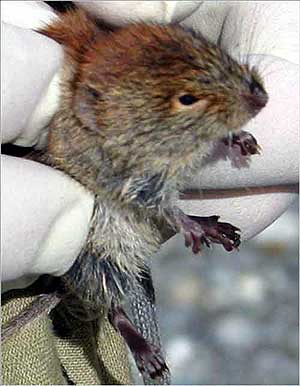 by Ned Rozell February 15, 2006
That's why a faint scratching noise surprised me on a recent walk. I looked to the source, a skinny spruce tree, and saw a red-backed vole looking me straight in the eye. It scrambled down the tree and into a hole in the snowpack, and left me with a question: what was that tiny, mouse-like creature doing out in that frigid air?
Ian van Tets has a few answers to that question. He is a biologist who studies voles and other northern animals at the University of Alaska Anchorage. He and two graduate students, Kalb Stevenson and April Brennan, are monitoring voles in the Eagle River Valley north of Anchorage, and they don't usually find them in trees or on the snow. "Running around on top of the snow is a good way to become an ex-vole," van Tets said. "They stand out on white background and the temperature up top is a lot colder than it is down under the snow." Small creatures use more energy to stay warm than large-bodied creatures. A moose, for example, retains heat easier than does a chickadee for much the same reason a hot tub stays unfrozen longer than a glass of water. Voles and lemmings spend most of their winter in the "subnivean" space between the snow and the ground, where the creatures have networks of tunnels warmed by the earth and insulated by the snow, van Tets said. Temperatures in the subnivean world can be as warm as 32 degrees Fahrenheit no matter how cold the outside air, and tiny creatures have access to food there, such as small tree roots and fungi. This begs the question of what a vole might be doing in a spruce tree at 40 below zero. Food is the most likely reason a vole would leave the sub-nivean world in extreme cold, van Tets said. "They're foraging constantly to pay the fuel bill," van Tets said. "If a vole could pop out of the snow, find some seeds in a tree and then get back under the snow it might be worth it, especially if while in the tree it was relatively sheltered from wind chill and predators." Foxes, owls, wolverines, lynx, weasels, and even wolves eat so many voles their populations can crash when voles are scarce. Avoiding one of those hunters may have been a good reason to climb a tree: "I am sure that voles are occasionally flushed out of the snow by predators and, having scattered, make do the best they can above ground until it is convenient and possible to go under again," van Tets said. "Hiding in a tree makes more sense than sitting out on top of the snow." Voles might also get kicked out from their subnivean pads, van Tets said. "Voles that are part of a nesting group sometimes aggressively exclude other voles from their area and might even kill a vole that did not make itself scarce. If making itself scarce means seeking temporary refuge above the snow in a tree then that, I suspect, is what the vole will do." The more he studies voles, the more van Tets admires them. At a time when bears hibernate and most birds escape Alaska and head for warmer places, voles thrive in a dark world beneath the snow, sometimes even breeding during the winter. "Voles and lemmings are, in my completely unbiased opinion, the truly tough animals of northern ecosystems," he said. "They don't migrate, hibernate or even use torpor to save energy. They just gut out the winter as best they can."
Publish A Letter on SitNews Read Letters/Opinions
|
||
